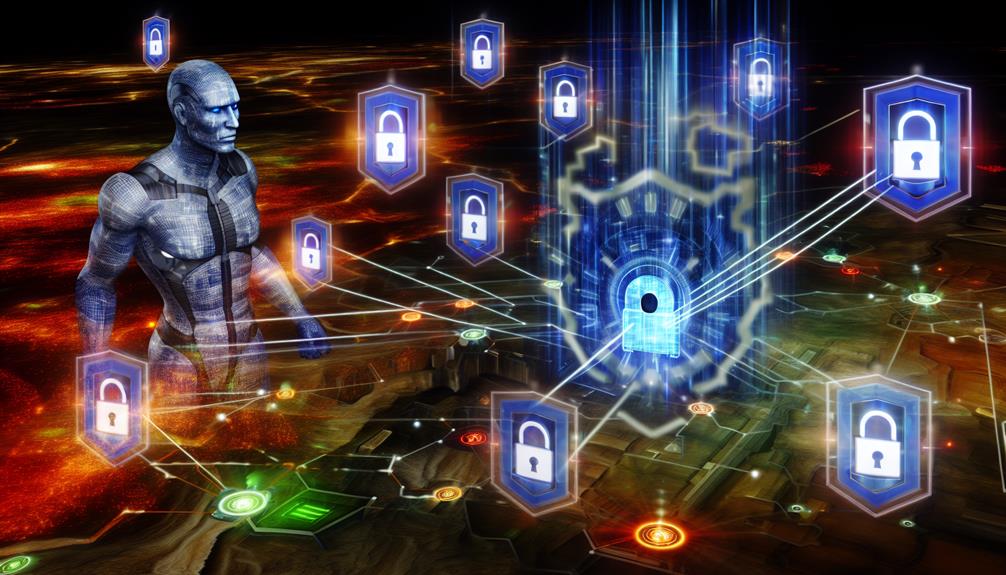When it comes to protecting your streaming domain, you need to take strategic steps to guarantee its security and integrity. Implementing measures like two-factor authentication and registrar locks can greatly reduce unauthorized access. You should also monitor expiration dates and consider using SSL certificates for user data protection. But there's more to it than just these basics; understanding the legal regulations and best practices can make a real difference in your domain's resilience. What other essential strategies could elevate your domain protection game?
Domain Protection in Streaming Services
Understanding what streaming domains are is essential for any platform aiming to deliver content effectively.
Protecting your domain not only safeguards your brand but also enhances accessibility for your audience, influencing their overall experience.
As you consider the technical aspects of domain protection, you'll recognize its significant impact on content delivery and user trust.
What Are Streaming Domains?
Protecting streaming domains is fundamental for maintaining the integrity and accessibility of online content. Streaming domains refer to the web addresses hosting your streaming services, allowing users to access and share video and audio content seamlessly online. These domains are significant assets, but they also face considerable risks from domain hijackers and cybercriminals, who may attempt unauthorized access or data breaches.
To enhance domain security, you should implement robust measures. Utilizing two-factor authentication and registrar locks can effectively safeguard your streaming domains from unauthorized transfers and modifications.
Regular monitoring of your domain registration details is essential; timely renewals prevent domain expiration, which could disrupt your streaming services.
Moreover, employing SSL certificates on your streaming domains is crucial. SSL certificates encrypt data transmission, ensuring that user interactions remain confidential and secure. They also verify the legitimacy of your streaming service, fostering user trust.
Importance of Domain Protection for Streaming Platforms
Protecting your streaming domain directly impacts user trust and satisfaction.
When users perceive strong security measures, they're more likely to engage with your service and share it with others.
Consequently, a compromised domain can lead to significant reputational damage and loss of subscribers.
How Domain Protection Affects User Trust
In the domain of streaming services, domain protection serves as a critical linchpin in maintaining user trust.
By implementing strong features like SSL certificates, registrar locks, and two-factor authentication, you safeguard user data, preventing unauthorized access and data breaches.
Regular domain renewals and transparent security practices further enhance your platform's credibility, ultimately fostering greater user confidence and loyalty in your streaming service.
Impact on Content Delivery and Accessibility
A secure streaming domain is essential for guaranteeing seamless content delivery and maintaining accessibility for your audience. Protecting your domain with effective domain protection measures can considerably reduce the risk of service outages. For instance, implementing registrar locking and two-factor authentication helps prevent unauthorized access, guaranteeing that your content remains accessible to viewers without interruption.
Regularly monitoring your domain's expiration date is critical; lapses can lead to service disruptions, negatively impacting viewer experience. Additionally, keeping your contact information updated with your registrar minimizes the risk of losing control over your domain.
SSL certificates play a pivotal role in enhancing your streaming domain's security. By encrypting data transmissions, they protect user privacy and foster viewer trust, essential for maintaining a loyal audience.
Moreover, utilizing WHOIS privacy protection safeguards your personal information, effectively mitigating the risk of domain hijacking. This not only guarantees the integrity of your streaming service but also reinforces its reliability.
Streameast Domains and Twitch Domains
Streameast domains primarily focus on live sports streaming, making them attractive targets for cyber threats, while Twitch domains cater to a broader streaming community.
Understanding the unique security challenges and features of both domain types is essential for streamers. By comparing these domains, you can identify effective strategies to protect your streaming identity and maintain an uninterrupted online presence.
What are Streameast Domains?
Live streaming platforms like Streameast provide users with access to a variety of sports and entertainment content through dedicated domains and subdomains. These domains are fundamental for delivering content efficiently and often include multiple subdomains to streamline user access to various streams.
However, managing these domains is essential to maintain their integrity and prevent unauthorized access. Effective domain management practices are significant in the face of potential cyber threats, such as phishing and domain hijacking. Implementing strong security measures, including regular domain renewal and enhanced privacy protection, guarantees that user data remains secure.
Additionally, Streameast domains must navigate legal challenges related to copyright infringements, which can complicate the balance between accessibility and compliance. The security of your streaming domain is paramount; without it, users risk exposure to malicious activities.
Overview of Twitch Domains
Twitch domains focus on real-time interaction, allowing you to engage directly with your audience during live broadcasts.
In contrast, Streameast domains cater to sports streaming but may lack the regulatory oversight that Twitch provides, introducing potential risks.
Understanding these differences is essential for streamers looking to secure their online presence and enhance their brand identity.
Key Features of Twitch Domains
The dynamic nature of streaming platforms necessitates a robust understanding of their unique web domains.
Key features of Twitch domains include:
- Main Hub: The primary domain, twitch.tv, centralizes live streams and content.
- Personalized URLs: Streamers create custom subdomains for enhanced branding.
- Interactive Features: Live chat and viewer participation foster community engagement.
Implementing security measures like strong passwords and two-factor authentication is essential to protect your Twitch domains.
Comparison of Streameast and Twitch Domains
When comparing Streameast and Twitch domains, it's clear that each platform serves distinct audiences and purposes within the streaming landscape.
Twitch, with approximately 140 million monthly active users, dominates the market, focusing on gaming and community interaction. Its well-established domain name contributes to brand loyalty and offers extensive features like monetization options and community engagement tools.
In contrast, Streameast caters to a niche audience interested in casual sports streaming and live events, but it lacks the same level of recognition and requires more marketing to build its brand.
When you think about domain name security, both platforms need to prioritize protecting their domain names to maintain user trust. If you want to protect your domain name, consider options like SSL certificates and regular updates to your domain registration information.
While Twitch's interactive approach enhances user experience, Streameast's streamlined focus on sports content minimizes distractions.
Ultimately, your choice between these domains should align with your content strategy and audience engagement goals. Evaluating features and brand recognition will help you make an informed decision on which streaming domain suits your needs best.
the Concept: Stream is Domain Protected
For streaming platforms like Streameast and Twitch, domain protection is essential to maintaining user trust and guaranteeing uninterrupted service. Securing your domain involves several key practices.
First, most domain registrars offer domain lock features, which prevent unauthorized transfers. Coupled with these protections, you should enable two-factor authentication to bolster your security against unauthorized access.
Additionally, utilizing SSL certificates on your domains encrypts sensitive viewer data, enhancing user trust. Regularly monitoring domain expiration dates and enabling auto-renewal is critical to avoid accidental domain loss. This guarantees that your streaming presence remains continuous and unbroken.
Implementing DNS security measures, such as DNSSEC, protects against DNS spoofing, directing viewers only to your legitimate site.
Furthermore, it's essential to keep your personal details updated with the domain registrar. This not only aids in recovery efforts should complications arise but also guarantees you receive timely notifications about your domain status.
Legal Regulations Surrounding Domain Protection
Understanding the legal regulations surrounding domain protection is essential for safeguarding your streaming domain.
You'll need to navigate complex frameworks like the ACPA and DMCA, which address trademark rights and copyright issues, respectively.
Furthermore, compliance with GDPR and local laws guarantees that your domain remains secure and minimizes the risk of legal complications.
Copyright and Trademark in Domains
In today's digital landscape, protecting your streaming domain involves maneuvering through complex legal regulations surrounding copyright and trademark rights. Copyright laws shield original works of authorship, meaning if you use copyrighted content without permission, you risk legal action and penalties. This infringement can lead to takedown notices or even litigation, disrupting your operations and tarnishing your online presence.
Trademark registration is equally critical; it safeguards your brand identity. By registering a trademark for your domain name, you prevent others from using names that are confusingly similar, thereby protecting your reputation. The Anticybersquatting Consumer Protection Act (ACPA) provides additional layers of protection, allowing you to seek legal remedies against those who register domain names that infringe on your trademarks with bad faith intent to profit.
To maintain your brand's integrity, regularly monitor for potential copyright or trademark violations related to your domain. Proactively addressing these issues not only protects your intellectual property but also strengthens your position in the competitive streaming landscape.
Legal Implications of Unprotected Domains
Unprotected domains expose you to a myriad of legal implications that can jeopardize your online presence and business operations. The risk of entering legal disputes increases considerably if your domain infringes on a registered trademark. Under the Anti-Cybersquatting Consumer Protection Act (ACPA), you could face severe penalties if you register a domain in bad faith, especially if it's tied to a trademark.
Moreover, registrars must comply with ICANN regulations that protect against unauthorized changes and domain hijacking. If your domain isn't secured, you could be held liable for damages if someone exploits it for illegal activities, such as phishing or fraud. This could implicate you in legal actions even if you weren't directly involved.
Additionally, it's essential to reflect on the legal landscape of personal information protection. Many jurisdictions have stringent laws aimed at safeguarding personal data linked to domain ownership. Failing to secure this information could lead to considerable fines and legal fallout.
Consequently, protecting your domain isn't just a matter of ownership; it's a vital legal necessity that impacts your overall business integrity and security.
How the Law Protects Streaming Domains
When your streaming domain lacks legal protection, you expose yourself to significant risks, including copyright infringement and trademark disputes.
Without safeguards, unauthorized users can easily exploit your content or brand, potentially damaging your reputation and revenue.
Understanding the implications of inadequate protection is essential for maintaining the integrity and success of your streaming domain.
What Happens When a Domain is Not Protected?
A vulnerable domain can become a target for hijacking, exposing streaming platforms to significant legal risks and ownership disputes.
Without implementing security best practices, such as registrar locks and two-factor authentication, your domain may face phishing attacks and potential trademark rights loss.
Additionally, compromised domains can lead to regulatory scrutiny and privacy violations, complicating recovery processes under laws like the DMCA.
How Can Users Ensure Their Stream is Protected by Domain?
Ensuring your streaming domain is legally protected requires a thorough understanding of various regulations that govern digital content.
First, familiarize yourself with the Digital Millennium Copyright Act (DMCA). This law safeguards against copyright infringement, which can jeopardize your domain if you host or distribute copyrighted material without proper authorization.
If you're streaming to audiences in the EU, compliance with the General Data Protection Regulation (GDPR) is vital. This regulation enforces stringent privacy and data protection standards for any personal information connected to your domain.
Additionally, carefully review the terms of service of your domain registrar and streaming platforms. Violating these terms can lead to domain suspension or legal repercussions.
To further protect your personal information, consider utilizing WHOIS privacy protection. This service keeps your details confidential, mitigating the risk of targeted legal actions or harassment linked to your domain.
Best Practices for Domain Protection in Streaming
To effectively secure your streaming domain, you must implement a combination of strong password protocols, two-factor authentication, and domain locking features.
Regular maintenance and monitoring of your domain's status are essential to prevent unauthorized access and guarantee ownership continuity.
Strategies for Securing Your Streaming Domain
Securing your streaming domain is essential for maintaining your online presence and protecting your brand. By implementing strategic measures, you can greatly reduce the risks associated with domain theft and unauthorized access.
- Enable Domain Lock: Activate the registrar lock on your streaming domain. This prevents unauthorized transfers and modifications, ensuring that only authorized personnel can make critical changes.
- Utilize Two-Factor Authentication: Set up two-factor authentication (2FA) for your domain registrar account. This adds an extra layer of security, drastically reducing the risk of unauthorized access, even if your passwords are compromised.
- Employ WHOIS Privacy Protection: Protect your personal information associated with your streaming domain by utilizing WHOIS privacy protection. This keeps your details confidential, safeguarding you against potential harassment or identity theft.
Regular Maintenance and Monitoring of Domains
How often do you check the status of your domains? Regular maintenance and monitoring are critical to guarantee the protection of your streaming domain. Start by regularly reviewing your domain expiration dates and setting up automated reminders. This helps you maintain continuous ownership and prevents unauthorized acquisition by competitors or squatters.
Conduct periodic security audits on your domain settings and configurations. Identify any unauthorized changes or vulnerabilities that could threaten your brand. Utilize domain monitoring services to receive alerts about any changes to your domain registration status or DNS settings, enabling you to act swiftly against potential threats.
It's also imperative to keep your contact information updated with your domain registrar. This facilitates prompt recovery efforts in case of a security breach or accidental domain loss.
Implement a routine check of your domain protection features, such as WHOIS privacy and registrar locks, guaranteeing they're active and functioning properly. These steps help safeguard your streaming domain against hijacking, providing you with peace of mind as you focus on delivering quality content to your audience.
Regular maintenance isn't just a task; it's a crucial strategy for your domain's longevity.
Case Studies of Successful Domain Protection
Successful domain protection hinges on the implementation of strategic best practices, as demonstrated by leading streamers who prioritize security to safeguard their online presence. For instance, many successful streamers employ registrar lock and two-factor authentication to thwart unauthorized transfers and access. One notable case involved a popular streamer who successfully fended off a hijacking attempt through these security measures.
Additionally, regular backups of domain and website data, including DNS settings, have become standard among top streaming platforms. This practice guarantees rapid recovery from potential threats or accidental changes, minimizing downtime.
Leading streamers also conduct periodic audits of their domain security tools and protocols, which help identify vulnerabilities and bolster defenses against phishing attacks.
Moreover, utilizing WHOIS protection services allows streamers to maintain confidentiality of their personal information, greatly reducing the risk of harassment and identity theft linked to public exposure of their contact details.
Engaging with cybersecurity communities and participating in training sessions on domain protection is common among influential streamers, enabling them to stay informed on the latest security trends and threats.
These case studies illustrate the effectiveness of proactive measures in safeguarding streaming domains.
Common Misconceptions about Domain Protection
Many streamers fall victim to common misconceptions about domain protection that can jeopardize their online presence. One prevalent belief is that registering a domain with a trusted registrar is sufficient. In reality, without features like registrar lock and two-factor authentication, your domain remains vulnerable to unauthorized transfers and hijacking.
Another misconception is underestimating the importance of WHOIS privacy. Failing to secure this can expose your personal information, making you an easy target for phishing attacks and spam.
Additionally, many streamers overlook the significance of monitoring their domain expiration date. Neglecting to renew your domain can lead to accidental loss, allowing competitors to snatch it up.
Moreover, some believe that a single strong password is enough for protection. However, employing password managers and regularly updating your passwords, along with two-factor authentication, greatly enhances your domain security.
Finally, it's a misconception that only large organizations need to worry about domain protection; individual streamers face similar risks of domain hijacking and must adopt best practices to safeguard their online assets.
Recognizing these misconceptions is essential to fortifying your streaming domain against potential threats.
Windstream Domain: A Case Study in Domain Management
Windstream's approach to domain management exemplifies best practices for securing streaming domains, highlighting the vital importance of thorough security measures. By implementing robust DNS security measures, including DNSSEC, Windstream effectively mitigates the risks of spoofing and unauthorized access to its streaming domains. Regular audits of domain management practices guarantee all security protocols remain current, minimizing vulnerabilities and protecting against domain hijacking.
A key component of Windstream's strategy is the use of registrar locking features. This safeguards domains from unauthorized transfers, guaranteeing that only designated personnel can modify domain settings. Additionally, the company employs two-factor authentication for all accounts related to its streaming domains, which adds an indispensable layer of security against potential breaches.
Windstream also maintains a proactive approach to monitoring its domains' expiration dates and renewal processes. Automatic renewals prevent accidental domain loss, guaranteeing continuous access to their streaming services.
Moreover, keeping contact details up to date with the registrar is essential; it allows for prompt communication regarding any domain issues. Through these extensive practices, Windstream demonstrates how careful domain management can protect streaming assets effectively.
Best Practices: Stream is Protected by Domain
Protecting your streaming domain requires a strategic approach grounded in best practices that enhance both security and user trust. Start by implementing SSL certificates on your streaming domain. This guarantees data transmission is encrypted, safeguarding user privacy and establishing credibility with your viewers.
Regularly renewing your domain registration, and enabling auto-renewal, prevents accidental expiration. This is imperative, as lapsed domains can lead to hijacking or loss of access to your platform.
Utilizing WHOIS protection is another key measure. By keeping your personal information private, you guard against harassment and potential identity theft from malicious actors.
Additionally, activating registrar lock on your domain is necessary. This feature prevents unauthorized transfers and changes, adding a critical layer of security against hijacking attempts.
To maintain continuous access to your streaming services, monitor your domain's expiration dates closely. Setting up automated alerts guarantees you're informed about renewal deadlines, allowing you to act promptly.
Future Trends in Domain Protection for Streaming Services
As streaming services increasingly rely on digital platforms, staying ahead of evolving security threats has become essential. Future trends in domain protection will focus on integrating decentralized domains and blockchain technology, notably enhancing security. This shift reduces the risk of hijacking and unauthorized domain transfers, making it harder for cybercriminals to compromise your streaming service.
Artificial Intelligence (AI) tools will play an important role in proactively monitoring domain activity. By detecting unusual patterns, these tools can help you prevent potential breaches before they escalate.
Additionally, the adoption of multi-layered security protocols, including SSL certificates and two-factor authentication, will be critical to fortify your domain against cyber threats.
Enhanced WHOIS privacy features will become increasingly important, as they protect personal information from stalkers and harassers. As a result, more streaming platforms will implement these features to safeguard their teams and users.
Lastly, regular cybersecurity training for your staff is non-negotiable. As threats continue to evolve, ensuring your team is equipped to handle domain security challenges effectively will be paramount.
Embracing these trends won't only protect your streaming domain but also enhance your overall security posture.




